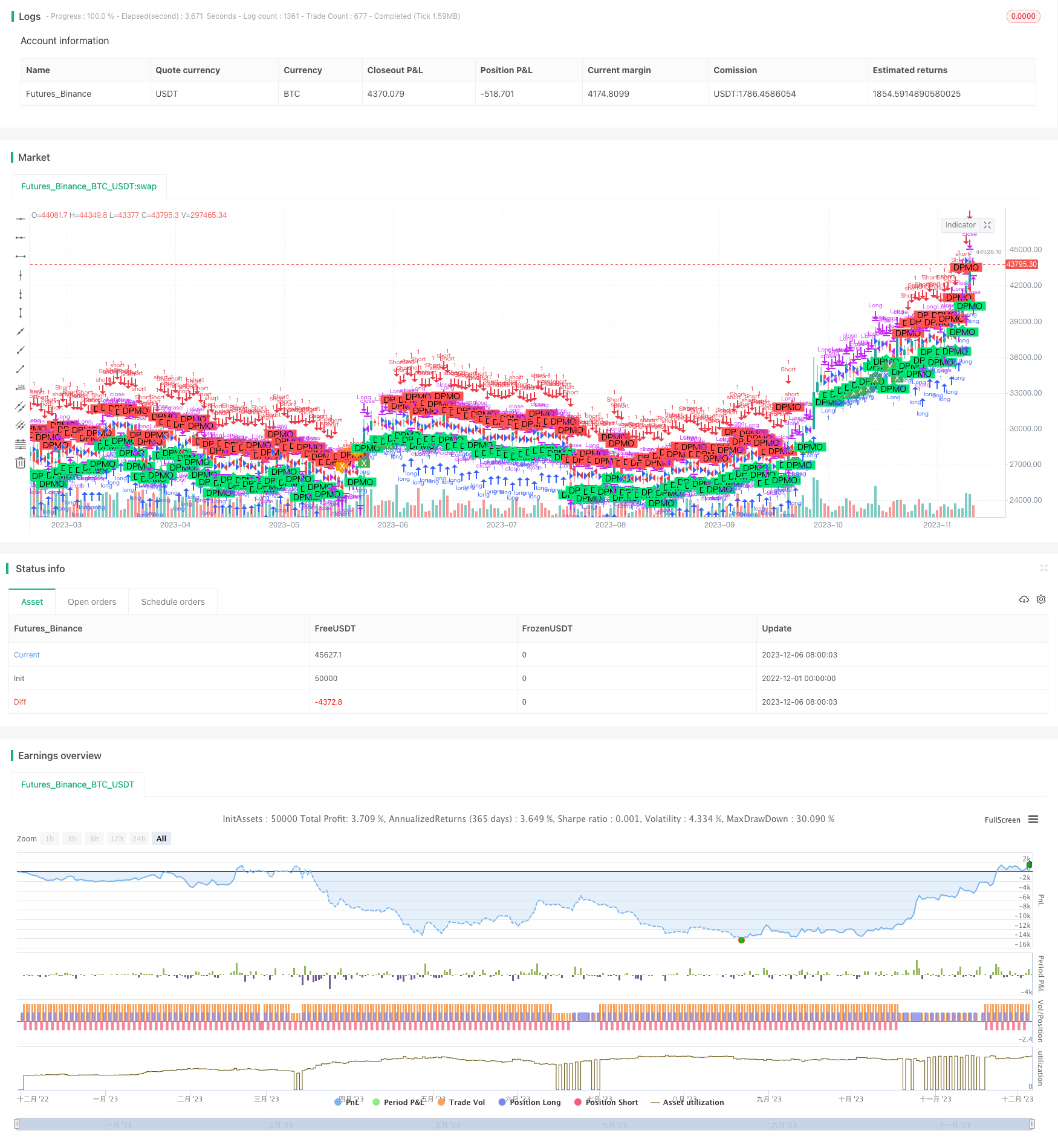Price Volatility Breakout Strategy Based on Double Moving Averages
Author: ChaoZhang, Date: 2023-12-08 16:44:22Tags:

Overview
The core idea of this strategy is to use price volatility to judge market trends. When volatility rises, it means the market is forming a new trend. And when volatility declines, it means the current trend is ending. The strategy calculates the percentage change of price and then filters it with double moving averages to get an indicator reflecting price volatility. It generates buy signals when the indicator crosses above its signal line, and sells signals when crossing below.
Strategy Logic
The strategy first calculates the percentage change of price:
i=(src/nz(src[1], src))*100
Then it filters i with a 35-period moving average to get the preliminary volatility indicator pmol2. Pmol2 is filtered again with a 20-period moving average to get the final indicator pmol. Finally, a 10-period moving average of pmol is used as the signal line pmols. Buy when pmol crosses over pmols and sell when crossing below.
Advantage Analysis
- The double MA filtering extracts volatility well and filters out noise.
- Calculating percentage change amplifies price movements, making trend changes more visible.
- Profit model is clear: buy at trend start, sell at trend end.
Risk Analysis
- Double filtering causes some lag.
- Percentage change calculation is sensitive to price amplitude.
- Need timely exits at bull-bear transitions.
Optimization Directions
- Optimize MA parameters to improve trend catching.
- Try different price change calculation methods.
- Add filters to avoid wrong signals.
Summary
This strategy uses percentage change and double MA filtering to extract price volatility and judge trend changes. It belongs to the relatively mature technical indicator strategies. The strategy has good trend catching capability but medium turning point recognition capability. Can optimize via parameter tuning and adding auxiliary conditions.
/*backtest
start: 2022-12-01 00:00:00
end: 2023-12-07 00:00:00
period: 1d
basePeriod: 1h
exchanges: [{"eid":"Futures_Binance","currency":"BTC_USDT"}]
*/
//@version=2
strategy("Strategy for DPMO", overlay=true)
src=input(close, title="Source")
length1=input(35, title="First Smoothing")
length2=input(20, title="Second Smoothing")
siglength=input(10, title="Signal Smoothing")
ebc=input(false, title="Enable Bar Colors")
upSign = '↑' // indicates the indicator shows uptrend
downSign = '↓' // incicates the indicator showing downtrend
exitSign ='x' //indicates the indicator uptrend/downtrend ending
calc_csf(src, length) =>
sm = 2.0/length
csf=(src - nz(csf[1])) * sm + nz(csf[1])
csf
i=(src/nz(src[1], src))*100
pmol2=calc_csf(i-100, length1)
pmol=calc_csf( 10 * pmol2, length2)
pmols=ema(pmol, siglength)
d=pmol-pmols
hc=d>0?d>d[1]?lime:green:d<d[1]?red:orange
buyDPMO = hc==lime and hc[1]!=lime
closeBuyDPMO = hc==green and hc[1]!=green
sellDPMO = hc==red and hc[1]!=red
closeSellDPMO = hc==orange and hc[1]!=orange
plotshape(buyDPMO, color=lime, style=shape.labelup, textcolor=#000000, text="DPMO", location=location.belowbar, transp=0)
plotshape(closeBuyDPMO, color=green, style=shape.labelup, textcolor=#ffffff, text="X", location=location.belowbar, transp=0)
plotshape(sellDPMO, color=red, style=shape.labeldown, textcolor=#000000, text="DPMO", location=location.abovebar, transp=0)
plotshape(closeSellDPMO, color=orange, style=shape.labeldown, textcolor=#ffffff, text="X", location=location.abovebar, transp=0)
barcolor(ebc?hc:na)
strategy.entry("Long", strategy.long, when=buyDPMO)
strategy.close("Long", when=closeBuyDPMO or sellDPMO)
strategy.entry("Short", strategy.short, when=sellDPMO)
strategy.close("Short", when=closeSellDPMO or buyDPMO)
- Dual Hull Moving Average Trading Strategy
- Price Change & Average Pricing Strategy Based on Quantitative Indicators
- Bollinger Percentage Bands Trading Strategy
- Trailing Take Profit Trailing Stop Loss Strategy
- Y-Profit Maximizer Strategy
- Breakout Trend Following Strategy
- SuperTrend-based Trend Tracking Strategy
- Strategy Based on Exponential Moving Average and MACD Indicator
- Index Trading Strategy Based on Bollinger Bands
- Exponential Moving Average Bounce Strategy
- SuperTrend and DEMA Based Trend Following Strategy
- End of Month Breakout on 200 Day Moving Average Strategy
- OBV Pyramid Strategy Based on Coinrule Script
- Quantitative Trading Based on Moving Average Envelope and ATR Trailing Stop
- ADX Crossover Trend Trading Strategy
- Crypto Bull Run Tracking Strategy
- SuperTrend Engulfing Strategy
- ADX-Based One-Hour TENKAN KIJUN Cross Trend Tracking Strategy
- MACD Moving Average Bull Bear Conversion Strategy
- Moving Average Crossover Strategy